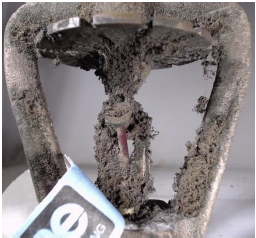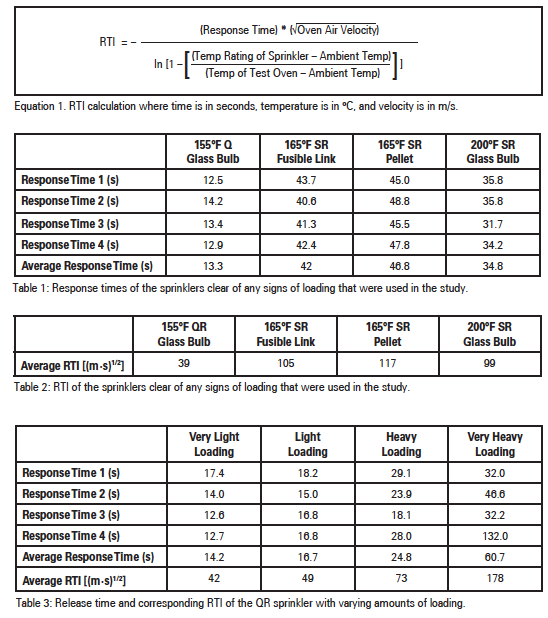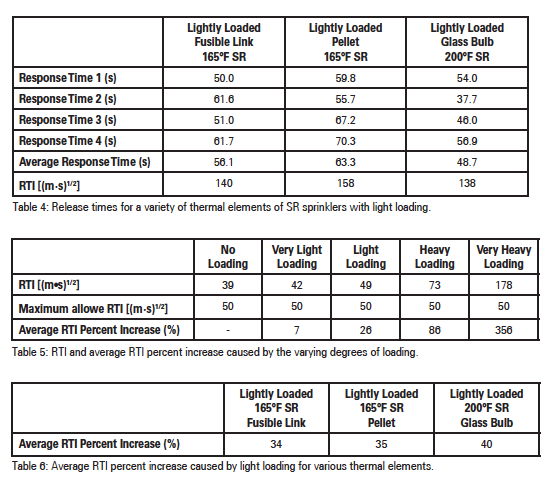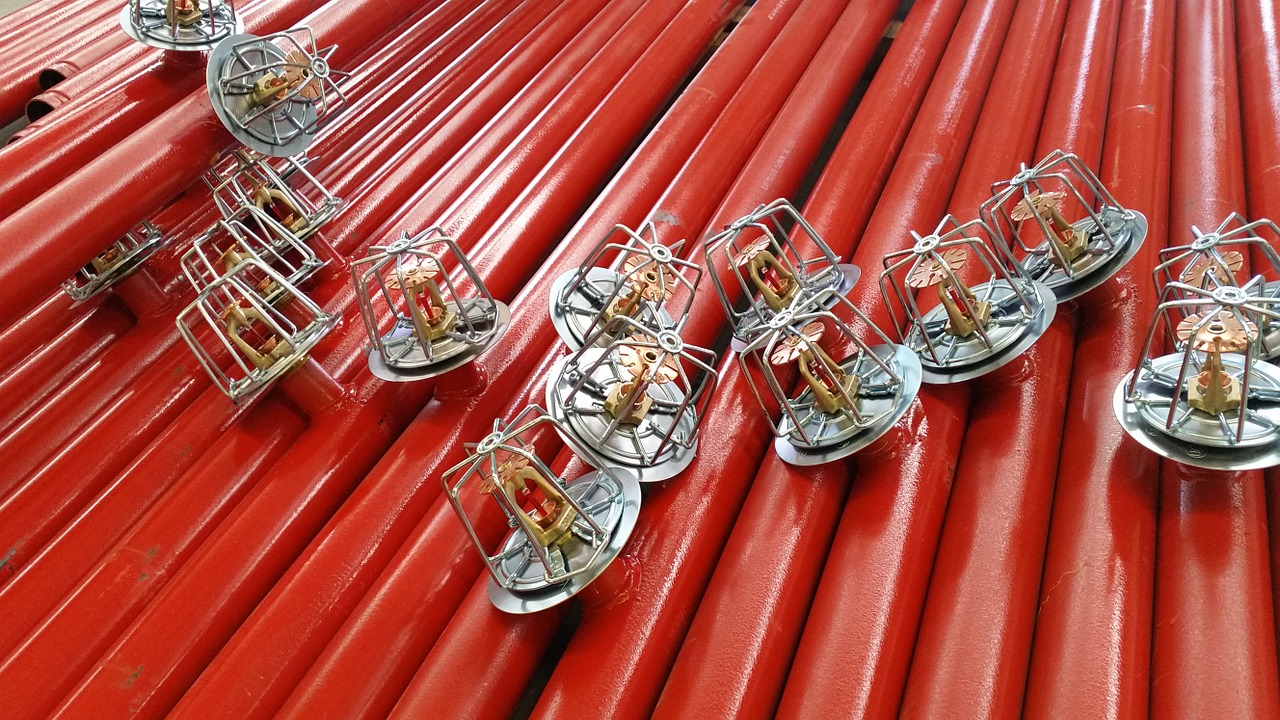A Look Into Loading’s Effect on Sprinkler Thermal Sensitivity
The 2017 edition of the NFPA 25, Standard for the Inspection, Testing, and Maintenance of Water-Based Fire Protection Systems, section 5.2.1.1.1 states that any sprinkler that shows signs of “loading detrimental to sprinkler performance” during the annual floor level inspection shall be replaced. According to NFPA 25 Annex A.5.2.1.1.1, “In lieu of replacing sprinklers that are loaded with a coating of dust, it is permitted to clean sprinklers with compressed air or a vacuum provided the equipment does not touch the sprinkler.”

Figure 1 shows an example of a previously installed sprinkler with loading. Is that loading detrimental to the sprinkler’s performance? Should the head be replaced or cleaned? The concern with loading is that it could insulate the thermal element, thus reducing the heat transferring to it and affecting release time. Using a plunge oven test method similar to those described in Underwriters Laboratories Standard 199, Automatic Sprinklers for Fire-Protection Service, and Factory Mutual 2000 Approval, Standard for Automatic Control Mode Sprinklers for Fire Protection, Dyne Technologies, LLC measured the response times of various sprinklers with different amounts of loading to help give an idea of how sprinkler thermal sensitivity is affected and when performance is no longer acceptable.
Test Conditions and Results
The sprinklers were attached to a plate and connected to an air pressure of 5 pounds per square inch (PSI) and were “plunged” into an oven with an air flow velocity of 2.5 meters/second (8.2 ft/second). The time was measured from when the sprinkler was plunged into the oven to when the pressure on the sprinkler dropped. Each condition in the study was run four times and the results were averaged. Table 1 on page 23 shows the response times of the various sprinklers used. The sprinklers used for the study were chosen based on availability but frequency of industry use was also considered.
In this study, thermal sensitivity was analyzed by comparing the response time index (RTI) for each sprinkler. The RTI of a sprinkler can be defined using an equation like Equation 1 on page 23. As defined in the 2016 edition NFPA 13, Standard for the Installation of Sprinkler Systems, section 3.6.4.8, a quick response (QR) sprinkler is defined as having a response time index (RTI) of less than 50 (meters·second)1/2 while a standard response (SR) sprinkler is defined as having a response time between 80 (meters·second)1/2 and 350 (meters·second)1/2. Based on the response time results, an RTI baseline was established for each sprinkler without loading. (See Table 2.)
The first half of the study tested QR sprinklers of the same make and model under the following conditions – 1) no loading, 2) very light loading, 3) light loading, 4) heavy loading and 5) very heavy loading. This was done to see how various amounts of loading impact the sprinkler’s RTI. Figure 2 shows the varying degrees of loading used in the study. Note that the loading for the study was made up of dust, lint and hair and was not quantified. The amount of loading and classification of light or heavy is subjective. Coverage, amount, and type can all play a role in affecting the response time. Example types include but are not limited to dust, lint, hair, grease, paint, and corrosion. Paint and corrosion are specifically called out in NFPA 25 separately and have different requirements than the other types of loading.

Table 3 shows the release times and corresponding RTI of the QR sprinkler under the various loading conditions. Remember that the RTI of the sprinkler clear of loading was 39 (m·s)1/2 and that the requirement for a sprinkler to be labeled as QR is that it must have an RTI under 50 (m·s)1/2.
The second half of the study involved different types of SR sprinklers with only light loading to see if different thermal elements are affected by loading differently. The results can be seen in Table 4 on page 24. Light loading was chosen for this part of the study as it could be the amount of loading where inspectors begin to question sprinkler performance.
Conclusion
While the overall loading study only researched a few types of sprinklers and amounts of loading, the results obtained still give some insight on how much loading is detrimental to a sprinkler’s performance. The results of the first half of the study show that, on average, very light loading and light loading did not increase the response time to the point that this sprinkler would no longer meet the definition of a QR sprinkler. However, heavy loading and very heaving loading did increase the response time enough to push it past the maximum allowed RTI of 50 (m·s)1/2. Table 5 on page 24 shows a comparison of RTI as well as the average RTI percent increase caused by the subjective varying degrees of loading.
The results of the second half of the study showed that the RTI for various SR thermal elements were all similarly impacted by light loading. Table 6 on page 24 shows a comparison of the average RTI percent increase caused by light loading on the various SR thermal elements. However, remember that SR sprinklers have a large allowed RTI range (80-350 (m·s) 1/2) compared to QR sprinklers (<50 (m·s) 1/2).
Therefore, if the RTI of an SR sprinkler clear of loading is on the lower end of the allowed range, which is fairly typical, a considerable amount of loading may be needed before the sprinkler no longer meets the definition of an SR sprinkler. So while thermal element types show similar impacts from loading, response type does play a role on whether the loading is considered detrimental or not. More research could be done to investigate the variables of this study further.
Any amount of loading can have some impact on the thermal sensitivity of a sprinkler. Even light loading can push the sprinkler’s RTI value near the allowed maximum as seen with the QR sprinkler. The question as to whether loading “is detrimental to the sprinkler performance” still depends on the sprinkler’s response type and RTI when clear of loading as well as the coverage, amount, and type of loading. The sprinkler shown in Figure 1 had an RTI of 35 (m·s) 1/2 which was well below the maximum allowed RTI of 50 (m·s)1/2 despite the loading. This confirms the need for NFPA 25’s language about replacement being needed only when the loading is detrimental to performance which can reduce unnecessary replacement costs. Since determining a sprinkler’s RTI cannot be done visually and this call is expected to be made during annual floor level inspections if the subjective call about loading cannot be comfortably made it is suggested the loading be treated as detrimental. When it comes to fire safety, don’t take the risk. Get loaded sprinklers cleaned, tested, or replaced according to NFPA 25.
 ABOUT THE AUTHOR: Grant Lobdell is the lab manager at Dyne Technologies, LLC – an ISO-certified testing laboratory providing independent analysis of fire sprinklers, firefighting foam, and antifreeze solutions to help ensure the performance of water-based fire protection systems. The easier the maintenance of fire protection systems is, the more likely it will be done to ensure fire safety. Lobdell can be reached at 800-632-2304 or grant@dyneusa.com.
ABOUT THE AUTHOR: Grant Lobdell is the lab manager at Dyne Technologies, LLC – an ISO-certified testing laboratory providing independent analysis of fire sprinklers, firefighting foam, and antifreeze solutions to help ensure the performance of water-based fire protection systems. The easier the maintenance of fire protection systems is, the more likely it will be done to ensure fire safety. Lobdell can be reached at 800-632-2304 or grant@dyneusa.com.
 Sprinkler Age A Publication of the American Fire Sprinkler Association
Sprinkler Age A Publication of the American Fire Sprinkler Association
